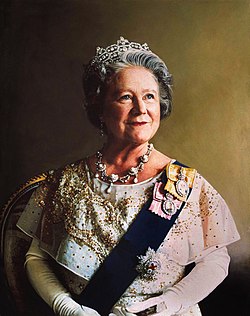Sweden
This section needs additional citations for verification .(January 2016) |
Kungens miniatyrporträtt (literally the "King's miniature portrait") is a royal decoration unofficially given to female members of the Swedish royal family. It is similar to the family orders of other European monarchies, although the Swedish royal court refers to it as "The King's portrait". [2]
History
The earliest known Swedish decoration is that of King Oscar II. At that time, Decorations did not have to be attached to the Seraphim blue ribbon that is the case today. As there are no earlier records of royal family decorations in Sweden, it might be assumed that the decorations were not introduced in Sweden until the reign of King Oscar II. Queen Sophia started "Sophiahemmet", a Red Cross nurse training program. At the graduation of the nurses, she presented a miniature portrait of the King on a white ribbon with a red cross. On the back was DSF inscribed in gold enamel on blue background. [3] In the 1900s Gustav V and his wife Victoria made a special form of the order with both of them in the portrait, painted by Fanny Hjelm, as a gift to their friend Countess Anna Brahe (born Anna Nordenfalk) when she visited them. [4] Currently recipients of the order wear it as part of their formal dress, often when their male counterparts wear medals. [5]
- Order with Gustav and Victoria
Appearance
The decoration currently consists of an oval portrait of a young King Carl XVI Gustaf half length. There are different versions of the portrait of the King, where he is dressed in admiral's uniform or simply formal wear with either the Seraphim band or chain. The portrait is framed by brilliant-cut diamonds and a brilliant bow at the portrait above page. The portrait is attached to a bow in Seraphim light blue ribbon and is held to the person's attire with a pin that is not seen. Different designs of the frame exist: some are more decorated than others.
Recipients
From King Oscar II
- Sofia of Nassau wearing the order of Oscar II
- Queen Sophia - (wife)
- Crown Princess Victoria - (daughter-in-law)
From King Gustaf V
- Queen Victoria - (wife)[ citation needed ]
- Queen Sophia [6] - (mother)
- Ingrid, Queen of Denmark - (granddaughter)[ citation needed ]
- Crown Princess Margaret - (daughter-in-law)[ citation needed ]
- Grand Duchess Maria Pavlovna - (daughter-in-law)[ citation needed ]
- Crown Princess Louise - (daughter-in-law)[ citation needed ]
- Princess Sibylla, Duchess of Västerbotten [7] - (granddaughter-in-Law)
From King Gustaf VI Adolf
- Queen Louise (wife)
- Ingrid, Queen of Denmark - (daughter)
- Princess Margaretha, Mrs. Ambler - (granddaughter)
- Princess Birgitta - (granddaughter)
- Princess Désirée, Baroness Silfverschiöld - (granddaughter)
- Princess Christina, Mrs. Magnuson - (granddaughter)
- Princess Sibylla, Duchess of Västerbotten - (daughter-in-law)
From King Carl XVI Gustaf

- Princess Margaretha, Mrs. Ambler (1st eldest sister)[ citation needed ]
- Princess Birgitta (2nd eldest sister)[ citation needed ]
- Princess Désirée, Baroness Silfverschiöld (3rd eldest sister)[ citation needed ]
- Princess Christina, Mrs. Magnuson (4th eldest sister)[ citation needed ]
- Ingrid, Queen Dowager of Denmark (aunt)[ citation needed ]
- Queen Silvia (wife) [8]
- Crown Princess Victoria [8] (1st daughter)
- Princess Madeleine, Duchess of Hälsingland and Gästrikland [8] (2nd daughter)
- Princess Lilian, Duchess of Halland (aunt by marriage)[ citation needed ]
- Princess Sofia, Duchess of Värmland (daughter-in-law)[ citation needed ]
- Queen Silvia wearing her order.
- Princess Madeleine wearing her order.
- Princess Birgitta wearing her order.
- Princess Christina, Mrs. Magnuson, wearing her order.










